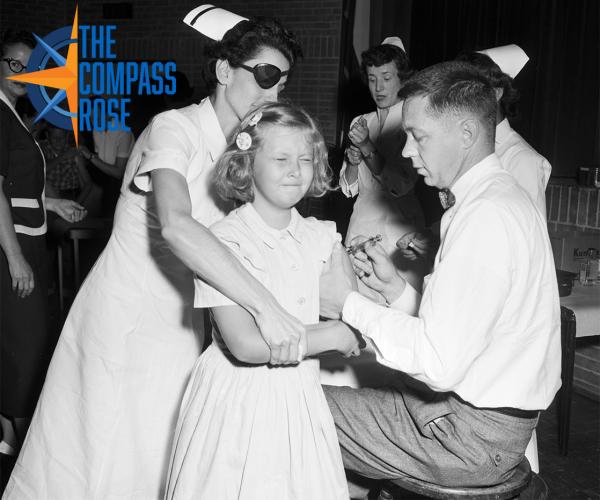
by Stephanie Luke


by Stephanie Luke
The purpose of The Compass Rose is to raise awareness of Special Collections' resources and to foster the use of these resources. The blog series also reports significant new programs, initiatives, and acquisitions of Special Collections.
As 2021 commenced, the approval of several COVID-19 vaccines has provided hope that we might soon see an end to the current pandemic. Although this wide-scale immunization movement is a truly historical moment, it is by no means the first. We here at Special Collections would like to look back at the polio epidemic of the 20th century and share some of the materials from our collections that highlight how North Texas was affected by the disease.
Poliomyelitis, more commonly referred to as polio, is an infectious disease that is contracted primarily by children and which can affect the spinal cord and central nervous system. As with COVID-19, the majority of those infected with polio are asymptomatic or develop only minor symptoms. The polio virus, however, can also result in serious conditions including meningitis, paralysis, and even death. Polio survivors may also develop long-term health problems, a condition that is referred to as post-polio syndrome.
Polio was initially described in 1789, but the first outbreak in the United States occurred over a century later, in 1894. Although there was a large epidemic in New York in 1916, polio reached its peak in the 1930s through 1950s. Texas was hit particularly hard during this period, and the state had outbreaks every year from 1942 to 1955. In fact, Harris County, Texas, experienced one of the largest outbreaks in the country in 1952. It was in this year that the United States saw its highest number of cases with over 57,000, nearly 4,000 of which were reported in Texas alone. To contextualize these numbers, in the 1950 Census, the population of the United States was 150.7 million, the population of Texas was 7.7 million (5.1 percent of the nation’s population), and the percentage of U.S. polio cases in Texas was 7 percent.
With such high rates of infection, especially among children, polio was a constant concern for Americans. The treatment of polio was often expensive, with the most serious cases requiring apparatuses like the tank respirator, also known as the iron lung, a machine that stimulates breathing in paralyzed patients. Furthermore, patients often needed physical rehabilitation to assist in their recoveries. Hospitals across the country created polio wards to treat patients who had contracted the disease. In 1921, a Dallas orthopedic surgeon partnered with the Scottish Rite Masons to found the Texas Scottish Rite Hospital for Crippled Children, which was the first hospital in the state dedicated to treating only pediatric polio and children with disabilities. The hospital continues to treat children to this day under its current name, the Scottish Rite Hospital for Children.
Campaigns to raise money for the fight against polio were common. In 1938, President Franklin Delano Roosevelt founded the National Foundation for Infantile Paralysis, today known as the March of Dimes. Roosevelt had contracted polio in 1921 and was active in advocating the importance of eradicating the disease, even meeting with other polio survivors when he visited Fort Worth in 1936. He was affected by the lasting effects of polio until his death in 1945. His advocacy, however, led to the development of a vaccine. The funds raised by the March of Dimes helped support the work of Jonas Salk.
Early attempts to develop a vaccine for polio proved unsuccessful. In 1935, trials began for two vaccines, but neither were effective. In fact, some of the patients not only experienced negative reactions but also contracted the disease. It wasn’t until almost 20 years later that trials began for another vaccine. In 1953, Jonas Salk developed a vaccine using the inactive polio virus that was delivered through an injection. The next year, almost two million children participated in the field trials of the Salk vaccine. Between 1955 and 1957, the incidence of polio in the United States fell by 85 to 90 percent. Soon after, Albert Sabin developed another vaccine that was delivered orally. By 1962, the Sabin vaccine had replaced Salk’s as it was cheaper to produce and easier to administer. In 1999, over 30 years after Sabin’s vaccine went to trial, it was replaced by another new, injectable vaccine. The efficacy of these polio vaccines is undeniable: no case of polio has originated in the United States since 1979.
United States Census for 1950. https://www2.census.gov/prod2/statcomp/documents/1951-02.pdf
“Whatever happened to polio?” Smithsonian National Museum of American History. https://amhistory.si.edu/polio/index.htm
Wooten, Heather Green. The Polio Years in Texas: Battling a Terrifying Unknown. Texas A&M University Press, 2009.
Comments
Polio vaccine
I would like to offer a slight correction to the photo of the girl getting a polio vaccination. It says this was the first such vaccination in Tarrant county. I was one of the students at West Van Zandt elementary in Fort Worth and we were vaccinated in the spring of 1954.
In reply to Polio vaccine by Lynn Walle
Polio
Lynn,
Thank you so much for commenting and sharing your experience! The Salk vaccine wasn’t approved until 1955, but field trials were happening in 1954. Is it possible that you were a participant in a field trial at the time you received the vaccine? We would love to hear more about what it was like to get this vaccine. If you are willing to share, please contact us at spcoref@uta.edu.
Add new comment